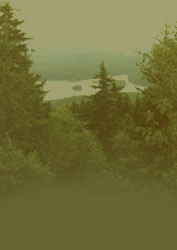|
Do you have something
happening in your corner of Washington? - Please call a member
or e-mail your observations to have them included here
This Month:
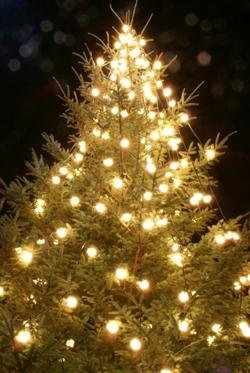
Photo from freefoto.com
Question: What can I do with my Christmas
tree when it is time to take it down?
Answer: You can recycle your tree as brush
at the transfer station, but there are several other ways
to put that tree to use!
Here are several ideas for ways you can re-purpose your tree
from the UNH Cooperative Extension:
1. Place it in a corner of your yard and hang orange slices,
balls of suet and other treats from the boughs to provide
food for the birds. The dense boughs also offer protection
for birds on cold winter nights and provide an escape from
nearby hawks or cats.
2. Clip off the branches and place the
boughs around marginally hardy plants, semi-hardy perennials
or around recently planted trees and shrubs. Leave the branches
in place until spring arrives, then cut them into small pieces
and add them to your compost pile.
3. Place the tree on its side in a woodsy area to serve as a
hiding place for small animals. Locate the tree so that wild
creatures that take up residence don't become pests later.
4. Run the branches through a wood chipper to produce mulch
for gardens, trees and shrubs. Pine mulch isn't toxic to plants,
but large amounts of chips (in case you acquire a large load
of Christmas trees from friends and neighbors) should be composted
first or allowed to sit for about 12 months before spreading.
November:
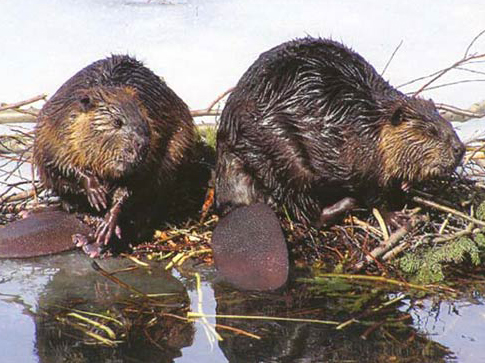
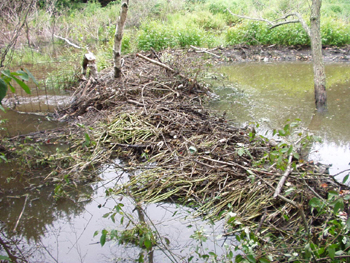
The beaver is North America's largest rodent.
Adult beavers typically weigh 45 to 60 pounds, but have been
known to grow to 100 pounds. Native Americans greatly respected
beavers, calling them "Little People".
The dams, canals and lodges that beavers build have gained
them the reputation as "Nature's Engineers". No other animal
with the exception of man so significantly alters it's habitat
to suit it's own needs and desires.
Beavers build and maintain houses called lodges. There are
two main types, the conical lodge and the bank lodge. The
most recognized type is the conical shaped dwelling surrounded
by water. It is made from sticks, mud and rocks. One of the
primary reasons beavers build dams is to surround their lodge
with water for protection from predators. The second type
of lodge is the bank lodge. It is typically excavated into
the bank of a large stream, river, or lake where the water
is too deep or fast moving to build the classic conical lodge.
Each lodge contains at least two water-filled tunnels leading
from the chamber to the pond so the beavers can enter and
exit the lodge underwater without being spotted by predators.
The walls of the conical lodge are very strong due to layers
of mud and sticks, and are extremely insulated. Even with
subzero outside temperatures it will not drop below freezing
inside the lodge due to retained body heat from the family
of beavers.
To obtain food and building materials, beavers are well known
for their ability to topple large trees using nothing but
their specially adapted incisor teeth and powerful lower jaw
muscles. Beaver teeth never stop growing, so they do not become
too worn despite years of chewing hardwoods. Their four front
teeth (incisors) are self-sharpening due to hard orange enamel
on the front of the tooth and a softer dentin on the back.
Therefore as beavers chew wood the softer backside of the
tooth wears faster, creating a chisel-like cutting surface.
In cold climates each Fall, beavers will stockpile a cache
of sticks underwater because they do not hibernate. They live
on these sticks because once their pond freezes they will
no longer have access to trees on the land. Beavers remain
inside their lodge all winter except when they swim under
the ice to their food cache for a stick to nibble on.
While beavers are considered to be pests by some, scientists
actually have proven that beavers are a "Keystone" species
in North America. This means that beavers play a crucial role
in biodiversity. Innumerable species rely either partly or
entirely on beaver ponds, many of them threatened or endangered.
Therefore, whenever we can coexist with beavers, we are providing
the habitat necessary for supporting many other species, and
protecting the web of life upon which we depend.
Where flooding from a free-standing beaver dam threatens human
property, health or safety, a Flexible Pond Leveler pipe system
can be an extremely effective solution. If properly designed
and built, a Flexible Pond Leveler will create a permanent
leak through the beaver dam that the beavers cannot stop.
A Flexible Pond Leveler device is so effective that Beaver
Solutions guarantee them. They eliminate the need for repeated
trapping despite the presence of beavers.
All information and much more
can be found at
Beaver Solutions
October:
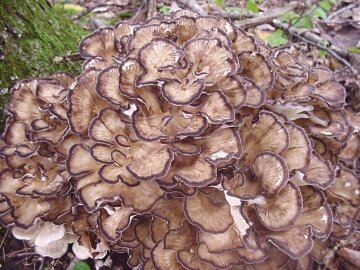
Photo from
American Mushroom
Carol recently found a very large mushroom called the "Hen
of the Woods" (scientific Name: Grifola frondosa).
It is easily recognized by its smoky brown, wavy caps, organized
in large clusters of rosettes arising from a single, branched
stem structure. The name "Hen of the Woods" refers to its
appearance, which strongly resembles a hen with ruffled feathers.
In the Appalachian region, it is called "Sheepshead" or "Ramshead".
It is also know by the name Maitake in Japan which means "dancing
mushroom". They can grow very large from several pounds to
over 50 pounds.
The Hen of the Woods fruits anytime from early September to
late October and seems to be triggered by the first cold nights
of the end of Summer. It is found growing mostly at the base
of dead or dying Oak trees, though it can be found under other
hardwoods and firs. "Hen of the Woods" grows from an underground
tuber-like structure, about the size of a potato. Once you
find one, go back the next year and you may find it again
in the same spot year after year.
Hen of the Woods is a very tasty edible mushroom, but one
should be careful to gather only younger specimens and trim
the softer, outer portions of the caps for the table. Succulent,
large and firm in texture, this mushroom has a strong earthy
or musty aroma, providing a flavor that is bold, somewhat
nutty and very similar to a Portobello. It is a variety of
fungus that is often valued for it's health benefits due to
the amount of fiber, protein, and vitamins B and C that it
contains.
Warning - Use caution when trying this species
for the first time; it is one of those for which "allergies"
in some individuals are reported. Try only a bite or two if
you have never eaten it before--and, if things go well (no
stomach upset), go ahead and eat it again. The sturdy mushroom
will definitely last a day or two in the refrigerator for
further consumption. They are easy to store. You can chop
the fronds up into what ever size pieces you like to cook
with and store them in freezer bags in the freezer without
any par-boiling, you can also dry in a food hydrator.
It is a very distinctive species with no dangerous "look-alikes",
making it a very good choice for the novice mushroomer. Happy
mushroom hunting!
September:
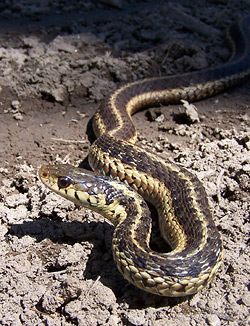
Photo by Mike Marchand
Snakes!!
Conservation Commission members have been spotting all kinds
of snakes lately. There are actually 11 different species
of snakes that are native to New Hampshire. Some of these
species, such as the garter snake are very common and widespread
across the state. Other species like the timber rattlesnake
are extremely rare and are now state protected. Five of the
11 species, the timber rattlesnake, eastern hognose snake,
northern black racer, smooth green snake, and ribbon snake,
were identified as species in greatest need of conservation
in New Hampshire’s Fish and Game Wildlife Action Plan completed
in the fall of 2005. Overall, NH snakes are poorly studied
and basic distribution and life history information is lacking.
Here are links to the NH Fish and Game website for pictures
and information on all 11 species of snake found in the state:
Garter
snake (Thamnophis sirtalis)
Ribbon
snake (Thamnophis sauritus)
Brown
snake (Storeria dekayi dekayi)
Northern
red-bellied snake (Storeria occipitomaculata
occipitomaculata)
Ringneck
snake (Diadophis punctatus edwardsii)
Smooth
green snake (Opheodrys vernalis)
Milk
snake (Lampropeltis triangulum triangulum)
Northern
black racer (Coluber constrictor constrictor)
Northern
water snake (Nerodia sipedon sipedon)
Eastern
hognose snake (Heterodon platirhinos)
State Threatened
Timber
rattlesnake (Crotalus horridus) State Endangered
This information found at:
NH Fish and Game Snake page
More information about snakes
can be found at: NH
Audubon
August:
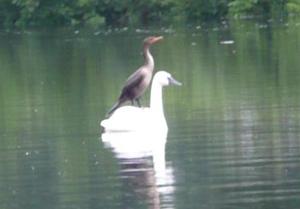

Who is that bird perched on the back of
the swan in East Washington's Mill Pond? We were surprised
to learn that he is a Double-Crested Cormorant!
This is a bird who loves to fish. The Double-Crested Cormorant
is a North American member of the Cormorant family of seabirds.
He is a large black bird, 29" to 36" long, with a wingspan
up to 52". He has a long tail and a yellow throat-patch with
a long, hooked, yellow beak, perfect for fishing.
Breeding occurs in coastal areas as well as near inland rivers
and lakes. They build stick nests in trees, on cliff edges,
or on the ground on suitable islands. They are gregarious
birds usually found in colonies and have a deep, guttural
grunt call.
Cormorants can find food in the sea, freshwater lakes, and
rivers. Like all Cormorants, the Double-Crested dives to find
its prey. It mainly eats fish, but will sometimes also eat
amphibians and crustaceans. Smaller fish may be eaten while
the bird is still beneath the surface but bigger prey is often
brought to the surface before it is eaten. After catching
a fish, the cormorant surfaces, flips the fish in the air
and swallows it head-first. They regurgitate pellets containing
undigested parts of their meals such as bones.
The Double-Crested Cormorant swims very low in the water,
often with just its neck and head visible, and dives from
the surface. It uses its feet for propulsion and is able to
dive to a depth of 525 feet for 3070 seconds.
After diving, it spends long periods standing with its wings
outstretched to allow them to dry, since they are not fully
waterproofed.
Let's hope he leaves a few fish for the fishermen that like
to visit Mill Pond.
Some information found at:
wildernessclassroom.com
Now, about those Canada Geese,
they can be a big nuisance! When geese nest on a pond or lake
they spend a lot of time eating and subsequently leaving their
waste in the water and on the shore (up to several pounds
a day!). This can be a direct major contribution to high bacteria
levels. Try to discourage them from nesting on your pond during
the summer. In East Washington, swan decoys have been installed
in the pond at three locations to discourage geese from nesting
and habitation. The geese don't want to stay where swans live.
Other methods are planting shoreline buffers of tall, native
plants that make it more difficult for the geese to enter
and leave the water, or just don't mow to the water's edge,
let the grass grow into a vegetative buffer. Don't allow feeding
of the birds at the pond. You can use a border collie to herd
them away from the pond's edge and make them feel like a predator
is around. But finally, if they have moved in and hatched
their brood you need to leave them alone and try again next
year.
July:
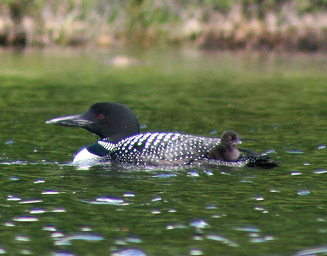
Picture by cinnabon1,
taken at Millen Pond
The name loon comes from
the bird's haunting, yodelling cry. Their unusual cries, which
vary from wails to tremolos to yodels, are distinct to the
individuals and can be heard at great distances. Loon cries
are most prevalent during breeding season as pairs aggressively
defend their territories.
The type of loon found here in Washington is called the "Common
Loon". These loons are the size of a large duck or small goose,
which they somewhat resemble in shape when swimming. Loons
have striking red eyes, black heads and necks, and white striping,
checkering, and spotting on their back and have a spear-shaped
bill. They ride low in the water and are excellent divers.
Loons find their prey by sight. They eat fish, amphibians
and crustaceans. Specifically, they eat crayfish, frogs, snails,
salamanders and leeches. They prefer clear lakes because they
can see their prey more easily through the water. The loon
uses its pointy bill to stab or grasp prey. They eat vertebrate
prey headfirst to help with swallowing, and swallow all their
prey whole.
To help digestion, loons swallow small pebbles from the bottoms
of lakes. This assists the loon in crushing the hard parts
of their food such as the exoskeletons of crustaceans and
the bones of frogs and salamanders. The pebbles may also be
involved in stomach cleaning as an aid to regurgitation of
indigestible food parts.
Loons may inadvertently ingest small lead pellets, released
by anglers and hunters, which will slowly lead to the loon's
death by lead poisoning. New Hampshire is one of the states
that has banned lead sinkers and shot to help protect loons
and other wild water birds.
During the summer, loons nest on fresh water lakes and/or
large ponds. Smaller bodies of water will usually only have
one pair. Larger lakes may have more than one pair, with each
pair occupying a bay or section of the lake.
Loons are excellent swimmers, using their feet to propel themselves
above and under water and their wings for assistance. Because
their feet are far back on the body, loons are poorly adapted
to moving on land. They usually avoid going onto land, except
when nesting.
Loons build their nests close to the water, preferring sites
that are completely surrounded by water. They may use the
same site from year to year. Loons will use a variety of materials
found nearby to build their nests including pine tree needles,
leaves, grass, moss, and sometimes clumps of mud. Both the
male and female help with nest building and incubation, which
usually lasts 26-31 days. If the eggs are lost, the pair may
re-nest, often in the same general location.
Usually one or two eggs are laid in June. Loon chicks are
able to swim right away, but are often seen riding on their
parents' back. This behavior allows the chicks to rest, conserve
heat, and avoid predators such as large carnivorous fish,
snapping turtles, gulls, eagles, and crows. After a day or
two, chicks cease returning to the nest but remain in their
parent's company.
Chicks remain with and are fed exclusively by their parents
for about eight weeks. After eight weeks, chicks will begin
to dive for some of their own food. By 11 or 12 weeks of age,
chicks are able to gather almost all of their own food and
may be able to fly.
A loon pair may mate for life, although banding studies have
shown that loons will sometimes switch mates after a failed
nesting attempt and even between nesting attempts in the same
season. Male loons appear more faithful to breeding territories
than to mates.
Come fall Loons migrate to the ocean coast to stay for the
winter.
Watch and listen for these wonderful birds in many of Washington's
ponds and lakes. We are fortunate to have them visit each
summer. The Loon Preservation
Committee in Moultonborough NH has worked to preserve
loons and their habitats in New Hampshire through research,
management and education activities. They conduct a loon count
each summer to monitor their population numbers.
Most information from:
Wikipedia
June:
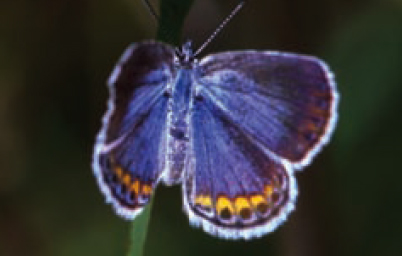
USFWS picture
The Karner blue butterfly
depends for survival on wild lupine plants, which once thrived
in pine barrens and oak savannahs in 12 northern states from
New England to Minnesota and in Ontario, Canada. Twenty years
ago there were an estimated 2,000 to 3,000 Karner blue butterflies
in the Concord Pine Barrens area. By 1995, that number had
plummeted to less than 50, because of the coinciding decline
of wild lupine in the area. The Karner blue butterfly was
federally listed in 1992 as endangered throughout its entire
range.
Both male and female have a wingspan of about an inch. The
upper side of the female's wings are bluish brown to blue
with orange crescents along the lower part of the hind wing,
while the male's are violet blue with unmarked narrow black
borders. In April, caterpillars hatch from eggs laid on wild
lupine plants the previous year. The caterpillars feed only
on wild lupine leaves. In mid May they form a cocoon-like
chrysalis from which they emerge as butterflies by the end
of May or early June. The adults mate and in June lay eggs
on or near wild lupine. The eggs hatch in about a week, and
the caterpillars enter the chrysalis stage about three weeks
later, appearing as a second generation of butterflies in
July. These adults mate and lay a second brood of eggs that
does not hatch until the following April. Adults feed on the
nectar of a variety of plant species. Wild lupine grows in
open pine barrens and oak savannahs, where sunlight reaches
the ground. These habitats often depend on fire to keep them
open. When fire is suppressed, as is often the case in areas
managed under traditional forestry techniques, the canopies
can close, and the lupine dies off.
The Karner blue butterfly is both New Hampshire's State Butterfly
and the Concord City Butterfly. Its restoration to the remaining
pine barrens plant community in the Concord, N.H., area has
involved a collaborative effort between state and local government
agencies, non-profit organizations, private businesses and
civic groups. Restoration efforts are focused at the Karner
Blue Butterfly Conservation Easement, part of the U.S. Fish
& Wildlife Service's Great Bay Wildlife Refuge, located at
the end of Chenell Drive (an educational kiosk near the site
explains the Karner project).
The New Hampshire Fish and Game Department's Nongame and Endangered
Wildlife Program oversees Karner blue restoration efforts
in the state. A variety of partners are involved in the restoration
efforts, including N.H. Fish and Game, the N.H. Army National
Guard, U.S. Fish and Wildlife Service, the city of Concord
and others. Core funding for captive rearing and habitat restoration
comes from the N.H. Army National Guard, the moose Conservation
License Plate and the U.S. Fish and Wildlife Service.
Wildlife biologists from N.H. Fish and Game release hundreds
of captive-reared Karner blue butterflies into the restored
habitat in June. The second of two annual broods will emerge
in July. Concord's school children and New England Zoo Conservation
Collaborative play an important role by helping to plant the
native lupines and other nectar-producing plants that the
endangered Karner blue butterflies rely on to survive. The
public is welcome to visit the easement at the end of Chenell
Drive in East Concord, where a trailhead kiosk describes the
Karner restoration project. Visitors are asked to try to not
step on any wild lupine plants -- there may be Karner blue
butterfly larvae on them.
For more information on Karner
blue Butterflies and the restoration project:
NH
State Wildlife Karner blue News
NH
State Wildlife Butterfly News
Roger
Williams Park Zoo News
National
Wildlife Federation Information on Karner blue Butterflies
FederalWildlife
Service Karner blue Factsheet
May:

National Geographic picture
The only hummingbird we have in New Hampshire
is the Ruby-throated Hummingbird, although
an occasional vagrant species turns up every once in a while.
The male ruby-throated has a red throat that will appear black
if it is not in the sun. The female has a whitish-gray breast
and both have a greenish back. The young resemble the female
during their first year. Capable of sustained hovering, hummingbirds
also have the ability to fly backward, vertically, sideways
and even upside down!
Hummingbirds return to our state in late April or early May.
Put up your feeder when the first really warm weather arrives
during that time. Feeders should be placed in partial shade.
To make your own nectar, bring to a boil a mixture of one
part sugar to 4-8 parts water and allow to cool. Hummingbirds
will investigate anything that is red, so if your feeder has
some red on it you do not need to put red dye in the nectar.
Do not use honey in your nectar because it can grow a fungus
fatal to hummingbirds. Change the nectar in your feeder and
put in fresh nectar every 3-4 days or more often in the hottest
days of summer. You should also clean the feeder at this time.
Store extra nectar in the refrigerator. Hummingbirds will
continue to feed on insects and other flowers in addition
to your feeder so they will get the diet they need. Hummingbirds
visit bee balm, wild columbine and cardinal flower and other
nectar bearing plants and bushes if you have planted them
in your yard.
Ruby-throated hummingbirds are among the tiniest birds on
the planet, but they're also among the biggest eaters. They
need to take in enough energy to supply wings that can beat
20 to 80 times per second and hearts that can beat more than
one thousand times per minute. They weigh about 1/10 of an
ounce and need to eat about every 10 minutes. Hummingbirds
have long thin bills adapted for specialized feeding. The
bill combined with an extendable, forked tongue, has evolved
in order to allow the bird to feed upon nectar deep within
flowers.
Hummingbirds migrate south at summer's end. Adults will usually
migrate first, often as early as the beginning of August.
The young usually stay longer and are gone by the end of September.
Research has shown that hummingbirds will migrate regardless
of whether there is food present, so you can leave your feeder
up until the weather turns colder and the hummingbirds are
gone.
Listen for the hum of the Hummingbird's wings and you will
be able to observe this tiny, jewel- like bird up close.
Most information found at:
NH Audubon Society
April:
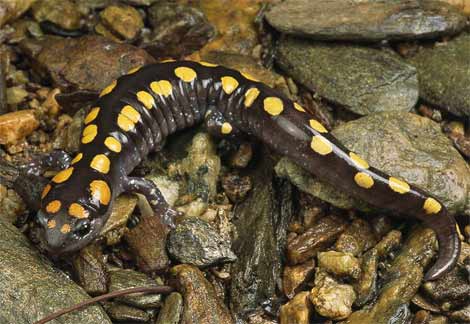
National Geographic picture
The Spotted Salamander
is one of the larger members of the mole salamander family
reaching lengths of 9 inches (23 centimeters) in length and
are prevalent in mature deciduous forests from eastern Canada
throughout the eastern and midwestern United States. But these
secretive salamanders spend almost their entire lives hidden
under rocks or logs or in the burrows of other forest animals.
They will populate upland forests and mountainous regions,
but are most common in moist, low-lying forests near floodplains.
They emerge from their subterranean hiding spots only at night
to feed and during spring mating. They will actually travel
long distances over land after a heavy rain to mate and lay
their eggs in vernal pools and ponds without fish. They return
to the same mating pool via the same route every year. They
lay up to 200 eggs in a single mass in early spring/late winter,
ususally after the first warm rain.
Visually striking, these stout salamanders are bluish-black
with two irregular rows of yellow or orange spots extending
from head to tail. Like many other salamanders, they secrete
a noxious, milky toxin from glands on their backs and tails
to dissuade predators. Their diet includes insects, worms,
slugs, spiders, and millipedes.
Spotted salamanders' numbers are generally stable throughout
their range, but they are very sensitive to changes in their
ecology, and rising water acidity in certain habitats is negatively
affecting their population. They may live 20 to 30 years.
Most information found at:
National Geographic website
March:
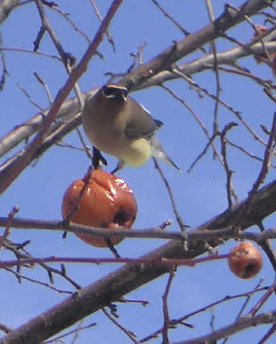
Birds! There are lots
of birds around this month as our winter birds are joined
by those that migrate in the spring. Johanna reports seeing
Cedar Waxwings in Concord early this month and was able to
snap this wonderful picture. A large flock was busy feasting
on some rotten apples left on the tree since last fall.
Carol mentioned that bird watchers are seeing Pine Grosbeaks
feeding on the ground under their feeders. These are not normally
seen in NH; they are normally further north but have come
down to find food. As much snow as we have had this winter,
they have had even more up north, so maybe their food is hard
to find. Carol also reports hearing a Redwing Blackbird; so
spring can’t be too far away!
Here are a few links for those interested in watching birds:
NH birding information
NH Rare Bird alert
For Kids:
Explore the World of NH birds
Don't forget to take down, clean and put away your bird feeders
by April 1 so you won't have trouble with bears. Store your
bird feeder until late fall when you can hang and fill it
again. Let us know what interesting birds you have seen lately!
February:
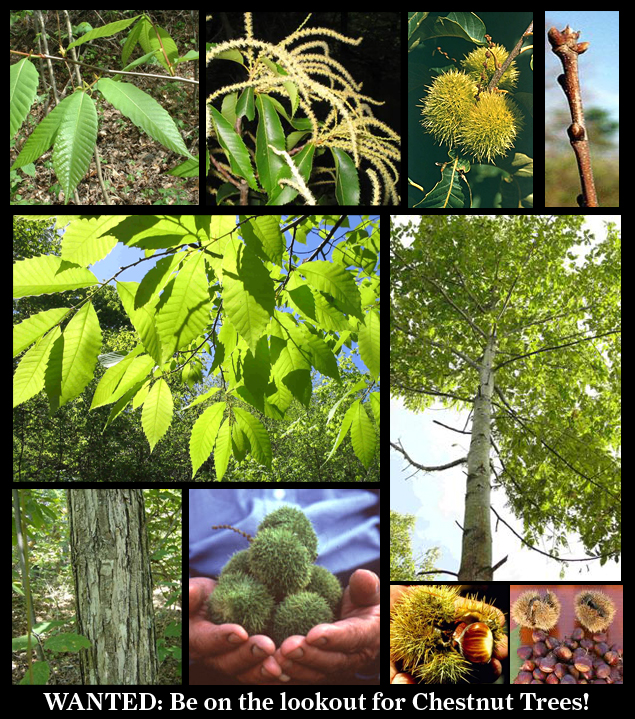
Wanted Alive: American Chestnut
Trees!
Don wants everyone to be on the lookout for the American Chestnut
Tree in the woods of Washington. He has contacted the Chestnut
Society about his chestnut trees and he thinks he may have
a significant mother tree. A blight-free tree would be a wonderful
find. Anyone who has seen one in Washington should let Don
know where it was found. He wants to remind people to think
twice before cutting a tree for firewood. See our wanted poster
above to help identify all the different parts of the tree.
The chestnut can look similar to an oak; so make sure of what
you are cutting. All chestnut trees should be left to grow
and propagate. Hopefully there will be a comeback of this
magnificent tree. More information about the Chestnut can
be found in our "New in Nature" yearly archives (link found
below). Look at year - 2007.
January:
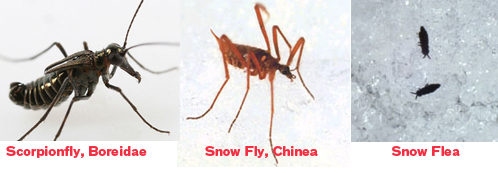
What's that bug and why is it walking
in the snow?
There are a surprising number of six-legged creatures that
are active when it is cold. While it may seem strange that
an insect would evolve to finish their development during
winter, they certainly have the advantage of having few predators
around.
So whether you are out cross country skiing, snow shoeing,
fishing, or maybe just walking through your front yard, be
on the watch for these fascinating insects.
The most familiar winter insect is the Snow Flea
commonly known as a springtail.
They are only 1/10th inch long, so they look like pepper on
the snow and can become so abundant they turn the snow black.
Another winter insect is the Snow Scorpionfly,
family Boreidae.
Scorpionflies have pronounced beaks and are wingless. They
are easy to see when they're on top of snow; they also found
in moss where both adults and larvae feed.
Another is the Snow Fly, genus Chionea.They
are wingless, spider-like, and active during cold weather.
They are dark colored and measure about 1/8 - 3/16 inch long.
Snow flies are most closely related to crane flies (those
things that look like huge, clumsy mosquitoes with enormously
long legs that normally fly around in the summer). The larvae
live somewhere in the leaf debris or topsoil or who-knows
where over the warm part of the year. Then, after the snow
falls, the adults come out and stride over the snow looking
for mates and a good place to lay their eggs. Most insects,
being cold-blooded animals, are active according to the temperature
of their environment. So these bugs have developed a cold
adaptation that is actually pretty extensive. They have significantly
altered biochemistry to allow them to not only avoid freezing
in the ice and snow, but still be able to function when their
body fluids are supercooled below the freezing point of water.
They only really run around when it is, literally, freezing
outside.
Find this information
and more about snow bugs at:
University
of Minnesota Extension Service
To view yearly archives of our "New In
Nature" series click on year you wish to see.
2002
2003
2004
2005
2006
2007
2008
2009
2010
2011
2012
|


